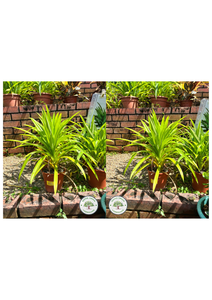
Height
1meter - $10
1.5meter - $25
2meter - $65
Syzygium Myrtifolium (Roxb.) Walp.
| Family Name: | Myrtaceae |
| Synonyms: | Syzygium sinubanense, Syzygium campanulatum var. longistylum, Eugenia parva, Syzygium campanellum, Eugenia myrtifolia, Eugenia oleina, Eugenia sinubanensis, Syzygium campanulatum |
| Common Name: | Kelat Oil, Kelat Paya, Red Lip, 红楠木 |
Description and Ethnobotany
| Growth Form | It is a tree with a dense bushy crown, up to 20 m tall. |
|---|---|
| Foliage | Its opposite, stalked leaves have leaf blades that are elliptic to lanceolate, about 7.5 cm long and 2.5 cm wide. Young leaves emerge reddish, turning red-brown then green. |
| Flowers | Its powderpuff-like flowers are cream to white in colour, borne on a branched inflorescence, up to 4 cm long. |
| Fruit | Its spherical to ellipsoid fruits are dark purple or black berries, about 9 mm wide. |
| Habitat | It grows in lowland primary and secondary forests, in coastal forests, near freshwater swamps and along riverbanks. |
| Similar | Same form and usage as the relatively new cultivar or variety tentatively known as Syzygium myrtifolium cultivar (dark red leaves), or named as 'Katsura' by certain Malaysian suppliers. This form produces dark red young foliar flush, as well as bright pink inflorescences. |
| Associated Fauna | Its flowers are insect-pollinated, and its fruits are eaten by birds. |
| Cultivation | Hardy plant, tolerates poor soils and salt spray, relatively pest-free. Does not tolerate drought. Tolerates partial shade, but exhibits slower growth, as well as sparser and less intense flush colouration. Takes pruning very well, can be trimmed regularly into various shapes, after which the plant sends out new foliar flush all over the pruned surfaces. Sensitive to transplanting, with fairly high mortality rate, transplanted specimens tend to shed leaves and require a period of time to recover from shock. Propagate by stem cuttings, air-layering or seeds. |
| Etymology | Genus epithet 'Syzygium' derived from 'syzygos' (Greek for 'joined'), alluding to the opposite paired leaves. Species epithet 'myrtifolium' means myrtle-leaved, describing how the plant's foliar shape and texture resemble the leaves of Myrtus. |
Full Sun
Lots of Water
Moderate Water
Bird-Attracting Plant
Butterfly-Attracting Plant
Native to Singapore
Coastal Plant
Suitable for Bonsai
Suitable for Roadsides
Fragrant Plant
Ornamental Leaves
Shrub
Tree


